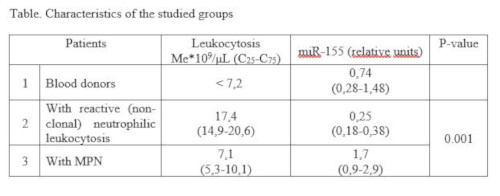
Contributions
Abstract: EP1110
Type: E-Poster Presentation
Session title: Myeloproliferative neoplasms - Clinical
Background
MiR-155 is involved in various physiological processes in the cell, including hematopoiesis, immunity, inflammation and differentiation. Increased expression of miR-155 is observed in many malignant diseases, including lymphomas, acute myeloid leukemia and CLL (Morales-Martinez M., et.al., 2020). Earlier (Stolyar M.A., et.al.,2020) we have demonstrated an increased miR-155 level in patients with chronic Ph-negative myeloproliferative neoplasms (MPN). Both an increase (Long L., et.al., 2013) miR-155 in blood mononuclear cells and a decrease (Kolarz B., et.al., 2020) in its level in the blood plasma of patients with rheumatoid arthritis have been described. At the same time, there are no results of a special study of miR-155 expression in reactive (non-clonal) leukocytosis.
Aims
To assess the diagnostic capability of determining miR-155 for the differentiation of non-clonal leukocytosis and MPN.
Methods
The study used anonymous (blind) EDTA venous blood samples from 107 patients with MPN (66-PV, 24-ET,17-PMF) and 20 patients with reactive neutrophilic leukocytosis above 12 * 109/μL, as well as 51 samples of voluntary blood donors. Determination of miR-155 in blood leukocytes was carried out by RT-PCR (Gene Formula Ltd.). The results were statistically evaluated using the R statistical package.
Results
In our study, the level of miR-155 in whole blood samples did not depend on the number of blood leukocytes. At the same time, its level in blood samples from patients without oncohematological disease does not significantly differ from the values typical for healthy people. On the contrary, in the group of patients with verified forms of MPN, the level of miR-155 in leukocytes was significantly increased (Table; p<0.001), although leukocytosis was less pronounced. There were no significant differences in the level of miR-155 between different variants of the MPN phenotype (PV, ET or PMF). Obviously, miR-155 overexpression is characteristic of cancer-transformed blood cells during myeloid proliferation.
Conclusion
The data obtained confirm the participation of miR-155 in the pathogenesis of MPN and suggest the possibility of using the miR-155 test as an additional diagnostic test for the differentiation of the clonal nature of the disease.
Keyword(s): Myeloproliferative disorder
Abstract: EP1110
Type: E-Poster Presentation
Session title: Myeloproliferative neoplasms - Clinical
Background
MiR-155 is involved in various physiological processes in the cell, including hematopoiesis, immunity, inflammation and differentiation. Increased expression of miR-155 is observed in many malignant diseases, including lymphomas, acute myeloid leukemia and CLL (Morales-Martinez M., et.al., 2020). Earlier (Stolyar M.A., et.al.,2020) we have demonstrated an increased miR-155 level in patients with chronic Ph-negative myeloproliferative neoplasms (MPN). Both an increase (Long L., et.al., 2013) miR-155 in blood mononuclear cells and a decrease (Kolarz B., et.al., 2020) in its level in the blood plasma of patients with rheumatoid arthritis have been described. At the same time, there are no results of a special study of miR-155 expression in reactive (non-clonal) leukocytosis.
Aims
To assess the diagnostic capability of determining miR-155 for the differentiation of non-clonal leukocytosis and MPN.
Methods
The study used anonymous (blind) EDTA venous blood samples from 107 patients with MPN (66-PV, 24-ET,17-PMF) and 20 patients with reactive neutrophilic leukocytosis above 12 * 109/μL, as well as 51 samples of voluntary blood donors. Determination of miR-155 in blood leukocytes was carried out by RT-PCR (Gene Formula Ltd.). The results were statistically evaluated using the R statistical package.
Results
In our study, the level of miR-155 in whole blood samples did not depend on the number of blood leukocytes. At the same time, its level in blood samples from patients without oncohematological disease does not significantly differ from the values typical for healthy people. On the contrary, in the group of patients with verified forms of MPN, the level of miR-155 in leukocytes was significantly increased (Table; p<0.001), although leukocytosis was less pronounced. There were no significant differences in the level of miR-155 between different variants of the MPN phenotype (PV, ET or PMF). Obviously, miR-155 overexpression is characteristic of cancer-transformed blood cells during myeloid proliferation.
Conclusion
The data obtained confirm the participation of miR-155 in the pathogenesis of MPN and suggest the possibility of using the miR-155 test as an additional diagnostic test for the differentiation of the clonal nature of the disease.
Keyword(s): Myeloproliferative disorder



